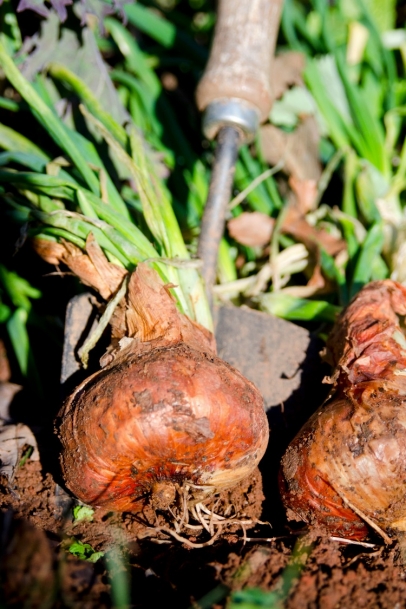A Potato Onion By Any Other Name...
Last week my daughter and I exploded in indignant derision when a TV sitcom claimed a character had bred “rasquats” from raspberries and kumquats. Typically, our family is content to suspend our disbelief for talking raccoons in space, wizard school, and a wellpreserved WWII-era superhero thawed like a 70-year-old box of fish sticks. Rasquats? Please, no. Plants have to be very closely related to be crossed with each other, which is why potatoes and onions (or raspberries and kumquats) will never create natural offspring.
A potato onion is an onion planted like a potato. Don’t worry, I’ll explain. When farmers harvest potatoes they keep the largest ones for eating and replant the smaller ones as “seed potatoes.” The tiny onion equivalent of seed potatoes are “sets.” Most of the onion sets available will grow a single bulb per set, and once that bulb is eaten the onion plant is dead. Potato onion sets produce a cluster of onion bulbs attached at the base (similar to a head of garlic with its fused cloves). Like potatoes, the larger bulbs are eaten and the smaller ones are replanted as the next generation of sets. This makes these onions a rare perennial vegetable and a great investment.
While potato onion is the most common name for them in the south, you may also hear multiplier onion, pregnant onion or mother onion used to describe this little plant’s self-propagating ability. It’s possible that northerners have their own passalong monikers since these onions are hardy up to USDA zone 5 (with mulch for protection). However, since northerners think the ocean is nice and warm when it hits 60°F, they’ve lost the right to name my favorite onion.
Taking the naming issues of potato onions even further, they are also at the center of heated arguments regarding exactly what constitutes a true shallot. Botanically speaking, potato onions are classified under the species Allium cepa var. aggregatum, but so are shallots. Aggregatum is not a specific vegetable variety like Staymen Winesap apples or Brandywine tomatoes, but a broad scientific label where botanists file all the aggregate (or multiple bulb) A. cepa onions. If you ask a botanist, you’ll hear that potato onions are nearly identical to shallots. If you pass this knowledge on to a dogmatic French farmer, you may end up as shallot fertilizer.
I love potato onions and think they are every bit as delicious as “true” shallots. The flavor isn’t as sharp as conventional onions and has a hint of garlic. The scales, or layers, of potato onions are succulent and crunchy, but thin enough to mince finely or slice into delicate rings. I find that they are delicious raw or cooked.
My perennial allium collection currently includes “yellow” potato onions, “white” potato onions, French red shallots, chives, garlic chives, Welsh bunching onions, Egyptian walking onions, ramps and garlic. Of these, the potato onions are by far the most practical to use in the kitchen. They’re a little smaller and milder in flavor than store-bought onions, but I view that as a good thing. It’s easier to harvest just the right quantity for a recipe and I don’t end up storing smelly onion halves in the fridge.
Potato onions are also the most versatile of my perennial alliums. You can use them as a respectable substitute in any recipe. The large bulbs are best as onions or shallots, the leaves function as chives or scallions, and the smaller bulbs work as larger scallions or leeks. I’ve found it is easy to store my potato onions right where they grow in the ground year-round in our area, but they’re also one of the very best onions for dry storage. Once they are harvested and cured (the outer skins air dried) they can keep for over a year without spoiling. They also make delicious pickles.
My favorite way to eat them is as a crispy fried topping, but that’s like saying my favorite pork cut is bacon. They’re wonderful minced raw into salad vinaigrettes, incorporated into a flavored butter, or peeled and roasted whole for 20 minutes as a side dish. Though they’ll add oniony flavor and crunch to any dish, the best way to highlight their more subtle flavor is with gentle cooking techniques and simple, complimentary ingredients that also grow in springtime: asparagus, radishes, tender greens and mushrooms.
In spite of the high price shallots fetch in the market and the relative rarity of potato onions, they’re one of the easiest foods to grow. They key to great potato onions, like any garden vegetable, is soil amended with plenty of organic matter. I’ve been adding deep hardwood mulch to my garden long enough now that I just tuck the potato onion sets here and there with my bare hands and forget about them. It’s such a quick task I can do it while I’m harvesting the largest bulbs for dinner. If you are starting with unamended clay, loosen the soil and mix in a minimum of three inches of compost, then mulch to retain moisture.
This is another old-timey vegetable that fell out of favor when farmers started looking for crops that took well to mechanical harvesting, so you’re unlikely to find them at markets or plant nurseries. Look for them online in catalogs selling passalong plants such as Southern Exposure Seed Exchange or Mulberry Woods Nursery. It’s a worthy pursuit; whether you decide to tell your friends you’re serving shallots or go with one of their more colloquial names, potato onions belong in your kitchen.
Southern Exposure Seed Exchange
PO Box 460
Mineral, VA 23117
www.southernexposure.com
540-894-9480
Mulberry Woods Nursery, Heirloom
Onion Division
330 Warrior Trail
Hayden, AL 35079
heirloomonions.com
205-586-9138





